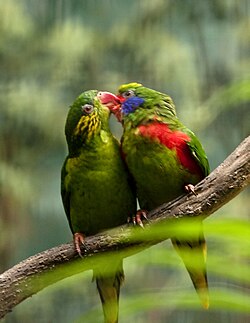| Hypocharmosyna | |
|---|---|
 | |
| Red-flanked lorikeets | |
| Scientific classification | |
| Kingdom: | Animalia |
| Phylum: | Chordata |
| Class: | Aves |
| Order: | Psittaciformes |
| Family: | Psittaculidae |
| Tribe: | Loriini |
| Genus: | Hypocharmosyna Salvadori, 1891 |
| Type species | |
| Psittacus placentis Red-flanked lorikeet Temminck, 1834 | |
Hypocharmosyna is a genus of parrots in the family Psittaculidae that are endemic to New Guinea, the Maluku Islands and the Bismarck Archipelago.